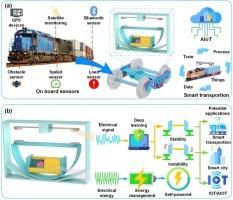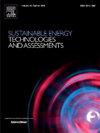A self-powered and self-sensing hybrid energy harvester for freight trains
IF 7.1
2区 工程技术
Q1 ENERGY & FUELS
Sustainable Energy Technologies and Assessments
Pub Date : 2024-09-27
DOI:10.1016/j.seta.2024.104004
引用次数: 0
Abstract
Freight trains, being crucial for economic development, often face challenges due to the lack of electrical infrastructure. In this study, a self-powered and self-sensing hybrid energy harvester system (SS-HEH) is proposed, it consists of an electromagnetic generator (EMG), a piezoelectric energy harvester (PEH), and an energy input module. The proposed EMG utilizes a rolling magnet to intersect the square coil, thereby better adapting to the operational conditions of freight trains and producing higher electrical energy output. Additionally, the PEH converts bogie vibration signals into electrical signals to detect bogie operations. The EMG acts on the PEH, inducing bending and generating electrical signals. Conversely, the PEH acts on the EMG to maintain it horizontally, enhancing its ability to absorb the vibration energy of the bogie and forming a bistable system. Furthermore, at a speed of 40 km/h, the EMG voltage with PEH increased by 43.75 % compared to the scenario without PEH. The electrical performance of the SS-HEH was assessed through shake table experiments, yielding an RMS voltage of 11.5 V and output power of 74.1 mW. In addition, combined with deep learning, SS-HEH has an accuracy of 97.41 % in detecting the operating status of bogie.

用于货运列车的自供电和自感应混合能量收集器
货运列车对经济发展至关重要,但由于缺乏电力基础设施,货运列车经常面临挑战。本研究提出了一种自供电和自感应混合能量收集器系统(SS-HEH),它由电磁发电机(EMG)、压电能量收集器(PEH)和能量输入模块组成。拟议的电磁发电机利用滚动磁铁与方形线圈相交,从而更好地适应货运列车的运行条件,并产生更高的电能输出。此外,PEH 将转向架振动信号转换为电信号,以检测转向架的运行情况。EMG 作用于 PEH,引起弯曲并产生电信号。相反,PEH 作用于 EMG,使其保持水平,从而增强其吸收转向架振动能量的能力,并形成一个双稳态系统。此外,在时速 40 公里的情况下,带 PEH 的 EMG 电压比不带 PEH 的情况增加了 43.75%。通过振动台实验评估了 SS-HEH 的电气性能,其有效值电压为 11.5 V,输出功率为 74.1 mW。此外,结合深度学习,SS-HEH 在检测转向架运行状态方面的准确率达到 97.41%。
本文章由计算机程序翻译,如有差异,请以英文原文为准。
求助全文
约1分钟内获得全文
求助全文
来源期刊

Sustainable Energy Technologies and Assessments
Energy-Renewable Energy, Sustainability and the Environment
CiteScore
12.70
自引率
12.50%
发文量
1091
期刊介绍:
Encouraging a transition to a sustainable energy future is imperative for our world. Technologies that enable this shift in various sectors like transportation, heating, and power systems are of utmost importance. Sustainable Energy Technologies and Assessments welcomes papers focusing on a range of aspects and levels of technological advancements in energy generation and utilization. The aim is to reduce the negative environmental impact associated with energy production and consumption, spanning from laboratory experiments to real-world applications in the commercial sector.
 求助内容:
求助内容: 应助结果提醒方式:
应助结果提醒方式:


